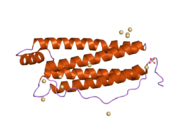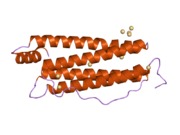Ferritin light chain
| FTL | |||
|---|---|---|---|
Gene ontology | |||
| Molecular function | |||
| Cellular component | |||
| Biological process | |||
| Sources:Amigo / QuickGO | |||
Ensembl |
| ||||||||
|---|---|---|---|---|---|---|---|---|---|
| UniProt |
| ||||||||
| RefSeq (mRNA) |
| ||||||||
| RefSeq (protein) |
| ||||||||
| Location (UCSC) | Chr 19: 48.97 – 48.97 Mb | n/a | |||||||
| PubMed search | [2] | [3] | |||||||
| View/Edit Human | View/Edit Mouse |
Ferritin light chain is a protein that in humans is encoded by the FTL gene.[4][5][6] Ferritin is the major protein responsible for storing intracellular iron in prokaryotes and eukaryotes. It is a heteropolymer consisting of 24 subunits, heavy and light ferritin chains.[6] This gene has multiple pseudogenes.[6]
It is abnormally expressed in fetuses of both
Function
Iron is extremely important in the development of neurons, transport through iron-sulfur clusters, the electron transport chain, and synthesis and breakdown of neurotransmitters. The function of the FTL is to act as both an iron reservoir and to remove excess iron from the body. Since iron plays a role in electron transfer, there is potential for the generation of free, highly toxic radicals which makes the role of the FTL as an iron detoxifier very significant.[8] The rates of iron uptake and release may be affected by changes to the components of the ferritin light chains and heavy chains.[6] Although the ferritin light chain unlike the ferritin heavy chain has no ferroxidase activity, the light chain may be responsible for the electron transfer across the ferritin protein cage.[9]
Clinical significance
Oxidative stress caused by iron radicals generated in the ETC and an increase in iron levels caused by defects in the FTL gene has been known to be a cause of the onset of neurodegenerative diseases and
Mutations of the FTL gene cause the rare adult-onset basal ganglia disease also known as neuroferritinopathy.[11] These mutations are specifically in exon four of the FTL gene. There are two distinct toxic mechanisms that lead to neuroferritinopathy and these are abnormalities in iron metabolism and the creation of free iron radicals, resulting in oxidative stress and cell death.[12]
Interactions
Ferritin light chain has been shown to
FTL is regulated by iron and with an increase in iron, there is both an increase in the FTL expression and PEN-2 levels, which results in increased γ- secretase activity. In relation to this, the downregulation of FTL expression leads to a decrease in the protein levels of PEN-2.[15]
See also
References
- ^ a b c GRCh38: Ensembl release 89: ENSG00000087086 – Ensembl, May 2017
- ^ "Human PubMed Reference:". National Center for Biotechnology Information, U.S. National Library of Medicine.
- ^ "Mouse PubMed Reference:". National Center for Biotechnology Information, U.S. National Library of Medicine.
- S2CID 2574558.
- PMID 9526618.
- ^ a b c d "FTL ferritin, light polypeptide". National Center for Biotechnology Information. 5 July 2009. Retrieved 20 July 2009.
- S2CID 206362532.
- ^ PMID 18171923.
- ^ PMID 25348725.
- PMID 17643933.
- PMID 21286947.
- PMID 24825732– via Hunter College Libraries.
- S2CID 4427026.
- S2CID 8235923.
- PMID 23685131.
Further reading
- Munro HN, Aziz N, Leibold EA, Murray M, Rogers J, Vass JK, White K (1988). "The ferritin genes: structure, expression, and regulation". Ann. N. Y. Acad. Sci. 526 (1): 113–23. S2CID 40903486.
- Cazzola M, Skoda RC (June 2000). "Translational pathophysiology: a novel molecular mechanism of human disease". Blood. 95 (11): 3280–8. PMID 10828006.
- Arosio P, Adelman TG, Drysdale JW (June 1978). "On ferritin heterogeneity. Further evidence for heteropolymers". J. Biol. Chem. 253 (12): 4451–8. PMID 659425.
- Gatti RA, Shaked R, Mohandas TK, Salser W (October 1987). "Human ferritin genes: chromosomal assignments and polymorphisms". Am. J. Hum. Genet. 41 (4): 654–67. PMID 2821803.
- Chou CC, Gatti RA, Fuller ML, Concannon P, Wong A, Chada S, Davis RC, Salser WA (February 1986). "Structure and expression of ferritin genes in a human promyelocytic cell line that differentiates in vitro". Mol. Cell. Biol. 6 (2): 566–73. PMID 3023856.
- Santoro C, Marone M, Ferrone M, Costanzo F, Colombo M, Minganti C, Cortese R, Silengo L (April 1986). "Cloning of the gene coding for human L apoferritin". Nucleic Acids Res. 14 (7): 2863–76. PMID 3754330.
- Boyd D, Vecoli C, Belcher DM, Jain SK, Drysdale JW (September 1985). "Structural and functional relationships of human ferritin H and L chains deduced from cDNA clones". J. Biol. Chem. 260 (21): 11755–61. PMID 3840162.
- Worwood M, Brook JD, Cragg SJ, Hellkuhl B, Jones BM, Perera P, Roberts SH, Shaw DJ (1985). "Assignment of human ferritin genes to chromosomes 11 and 19q13.3----19qter". Hum. Genet. 69 (4): 371–4. S2CID 23574066.
- Dörner MH, Salfeld J, Will H, Leibold EA, Vass JK, Munro HN (May 1985). "Structure of human ferritin light subunit messenger RNA: comparison with heavy subunit message and functional implications". Proc. Natl. Acad. Sci. U.S.A. 82 (10): 3139–43. PMID 3858810.
- Caskey JH, Jones C, Miller YE, Seligman PA (January 1983). "Human ferritin gene is assigned to chromosome 19". Proc. Natl. Acad. Sci. U.S.A. 80 (2): 482–6. PMID 6572903.
- Addison JM, Fitton JE, Lewis WG, May K, Harrison PM (November 1983). "The amino acid sequence of human liver apoferritin". FEBS Lett. 164 (1): 139–44. S2CID 21144293.
- Girelli D, Corrocher R, Bisceglia L, Olivieri O, De Franceschi L, Zelante L, Gasparini P (December 1995). "Molecular basis for the recently described hereditary hyperferritinemia-cataract syndrome: a mutation in the iron-responsive element of ferritin L-subunit gene (the "Verona mutation")". Blood. 86 (11): 4050–3. PMID 7492760.
- Beaumont C, Leneuve P, Devaux I, Scoazec JY, Berthier M, Loiseau MN, Grandchamp B, Bonneau D (December 1995). "Mutation in the iron responsive element of the L ferritin mRNA in a family with dominant hyperferritinaemia and cataract". Nat. Genet. 11 (4): 444–6. S2CID 25573910.
- D'Agostino P, Faniello MC, Quaresima B, Bevilacqua MA, Tiano MT, Ammendola R, Cimino F, Costanzo F (October 1995). "Negative and positive elements in the promoter region of the human apoferritin L gene". Biochem. Biophys. Res. Commun. 215 (1): 329–37. PMID 7575610.
- Rogers JT, Andriotakis JL, Lacroix L, Durmowicz GP, Kasschau KD, Bridges KR (July 1994). "Translational enhancement of H-ferritin mRNA by interleukin-1 beta acts through 5' leader sequences distinct from the iron responsive element". Nucleic Acids Res. 22 (13): 2678–86. PMID 8041631.
- Spanner M, Weber K, Lanske B, Ihbe A, Siggelkow H, Schütze H, Atkinson MJ (August 1995). "The iron-binding protein ferritin is expressed in cells of the osteoblastic lineage in vitro and in vivo". Bone. 17 (2): 161–5. PMID 8554925.
- Rogers JT (March 1996). "Ferritin translation by interleukin-6: the role of sequences upstream of the start codons of the heavy and light subunit genes". Blood. 87 (6): 2525–37. PMID 8630420.
- Pang JH, Jiang MJ, Chen YL, Wang FW, Wang DL, Chu SH, Chau LY (May 1996). "Increased ferritin gene expression in atherosclerotic lesions". J. Clin. Invest. 97 (10): 2204–12. PMID 8636399.



